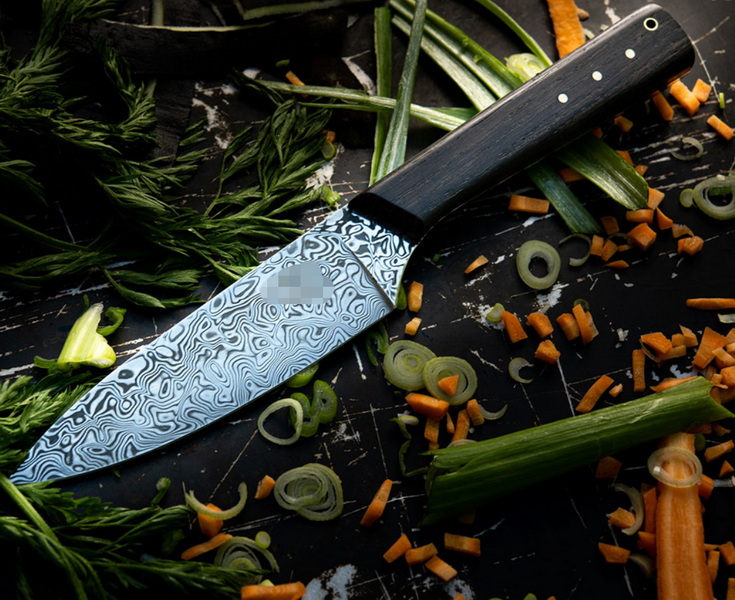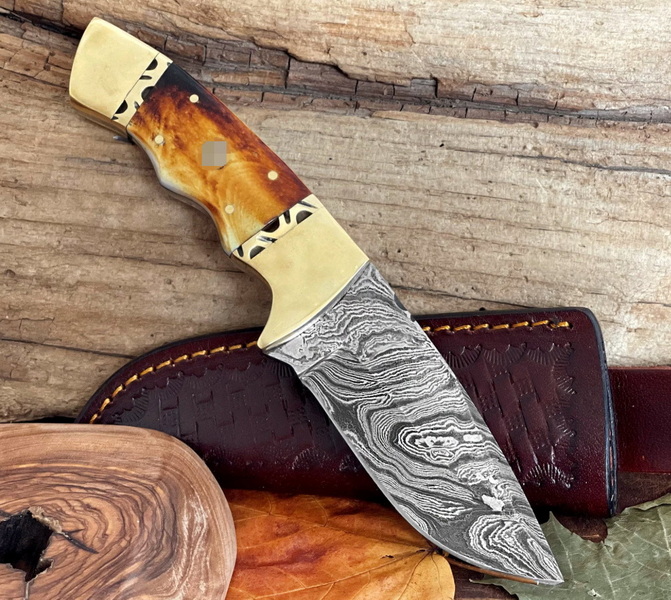- All
- Product Name
- Product Keyword
- Product Model
- Product Summary
- Product Description
- Multi Field Search
Views: 222 Author: Ann Publish Time: 2025-10-14 Origin: Site











Content Menu
● What is a Carbon Steel Knife?
>> 1. Blade Hardness and Sharpness
>> 2. Appearance and Aesthetics
>> Longevity
>> Suitability for Different Cooking Styles
● Frequently Asked Questions (FAQs)
>> 1. What makes Damascus knives visually unique?
>> 2. Are carbon steel knives prone to rust?
>> 3. Which knife is easier to sharpen?
>> 4. Does Damascus steel affect cutting performance?
>> 5. Is the higher price of Damascus knives justified?
When choosing a kitchen knife, two popular options often come into consideration: the Damascus knife and the carbon steel knife. Each offers distinct characteristics that may suit different kitchen needs and preferences. This article explores the key differences between these two types of knives, their advantages, disadvantages, and typical uses to help you make an educated decision.

A Damascus knife is crafted by forging together multiple layers of steel or steel alloys, producing distinctive flowing, wavy patterns on the blade which are visually striking. While the exact ancient method of producing original Damascus steel is lost, modern production replicates similar patterned steel often prized for its beauty and craftsmanship.
- Appearance: Unique and artistic wave patterns on the blade.
- Material: Multiple layers of steel combined for aesthetics and performance.
- Durability: Generally resistant to rust and wear.
The Damascus steel manufacturing process is complex, involving repeated heating, folding, and hammering the steel layers to create not only a pattern but also a strong, durable blade. This layered structure helps combine the best properties of different steel types, such as toughness, hardness, and flexibility. The lower layers provide toughness, while the harder upper layers produce a sharp cutting edge.
Carbon steel knives are made from steel containing a higher proportion of carbon compared to stainless steel. This composition makes the blade harder and allows it to retain a sharp edge for longer periods, a feature highly regarded by professional chefs.
- Appearance: Usually plain metal finish; develops a natural patina over time.
- Material: High carbon content steel.
- Edge retention: Superior sharpness and precise cutting ability.
Carbon steel knives are known for their exceptional edge retention and ease of sharpening. The higher carbon content means the blade can be made harder than stainless steel knives, which translates to longer-lasting sharpness and superior cutting performance. However, with these benefits comes increased susceptibility to rust and corrosion if not properly maintained. Chefs often favor carbon steel knives for tasks requiring precision slicing and fine cuts.
- Carbon steel blades are typically harder and can maintain sharper edges for delicate, precision cutting.
- Damascus knives offer balanced sharpness but focus more on the blade's craftsmanship and durability.
The hardness of carbon steel blades can often reach higher levels on the Rockwell scale compared to Damascus steel, making them able to cut finer and hold their edge longer. Damascus knives, while also hard, balance aesthetics with function but may require more frequent sharpening for professional-level edge maintenance.
- Damascus blades are well-known for their eye-catching patterned finish, making them popular among collectors and enthusiasts.
- Carbon steel knives have a simpler look but acquire a unique patina with use, treasured by traditionalists.
The captivating visual appeal of a Damascus knife is often the strongest pull for buyers. The flowing layered patterns are unique to each blade, making every Damascus knife a piece of art. Carbon steel knives lack this ornamental look but develop a patina—a natural oxidation layer giving a rustic and vintage look appreciated by many chefs.
- Carbon steel blades are prone to rusting if not properly cared for due to low chromium content.
- Damascus knives are generally more rust-resistant but still require maintenance to retain their luster and edge.
While carbon steel knives need frequent cleaning, drying, and occasional oiling to prevent rust, Damascus knives usually contain some stainless steel in their layered construction, increasing corrosion resistance. Nevertheless, both knives benefit from careful care, such as avoiding dishwashers and exposure to acidic foods for long periods.
- Damascus knives often command higher prices reflective of the craftsmanship and artistic value.
- Carbon steel knives are more economically viable but can also represent excellent quality.
The process of making Damascus knives, including forging multiple layers and etching the blade for pattern visibility, is labor-intensive and can justify higher retail prices. Carbon steel knives, while traditionally simpler, offer outstanding value, especially for professional chefs who prioritize function over artisanal detail.
- Carbon steel knives excel in sharpness and edge retention favored by professionals for precise culinary tasks.
- Damascus knives offer balanced performance suitable for general kitchen use and some outdoor activities.
In professional kitchens, carbon steel knives often dominate for cutting vegetables, meats, and delicate ingredients requiring precision. Damascus knives, blending toughness with durability, are excellent general-purpose knives for home chefs and collectors who want both performance and style.

Carbon steel knives tend to be lighter, which some chefs prefer for nimble and fast cuts. Damascus knives with layered steel can be slightly heavier, offering a reassuring heft that can improve cutting stability in heavier tasks.
Damascus knives generally have a modest amount of flexibility due to their layered construction, which can reduce the risk of chipping. Carbon steel knives tend to be harder but less flexible, which requires careful handling to avoid edge damage during heavy use.
With proper maintenance, both Damascus and carbon steel knives can last many years. Carbon steel knives may require more frequent sharpening and rust prevention, while Damascus knives might maintain sharper edges for longer but could lose the distinct pattern if stripped due to heavy refinishing.
- Carbon steel knives, known for razor-sharp edges, suit chefs focused on fast, intricate slicing—e.g., Japanese cuisine.
- Damascus knives, balancing aesthetics and toughness, serve well in Western and fusion cuisines where visual and functional appeal both matter.
Choosing between a Damascus knife and a carbon steel knife depends largely on personal preference, intended use, and maintenance willingness. Consider these points:
- Cutting precision and sharp edge retention? Choose carbon steel.
- Aesthetic appeal and unique craftsmanship? Damascus knives excel here.
- Balanced durability with visual artistry? Damascus offers this blend.
If you enjoy regular knife maintenance and want a razor-sharp cutting tool, carbon steel knives could suit you best. Alternatively, if the blade's appearance and layered craftsmanship intrigue you and you want a versatile kitchen knife, Damascus knives are excellent options.
Damascus knives and carbon steel knives each bring unique benefits to the kitchen, differing primarily in aesthetics, cutting performance, maintenance needs, and price. Carbon steel knives offer superior sharpness and edge retention, favored for professional sharpening precision but require care to prevent rust. Damascus knives combine durability with artistic appeal through their distinctive layered patterns, making them popular choices for gifts or collectors while still performing well in most culinary tasks. Your choice should reflect your cooking style, care commitment, and appreciation for craftsmanship versus pure function.

Their distinctive wavy layered steel pattern produced by forging different steels together.
Yes, due to lower chromium, they require regular cleaning and oiling to prevent corrosion.
Carbon steel knives are generally easier to sharpen with basic skills compared to multi-layer Damascus blades.
While visually dramatic, Damascus steel blades usually balance aesthetics with good sharpness but may not surpass carbon steel's edge retention.
Often yes, because of the artisan craftsmanship and unique blade patterns making each knife one-of-a-kind.
The Ultimate Professional Knives for Halal Butchery in Middle Eastern Kitchens
Chef Knife Size Guide: Choosing Between 6″, 8″, 10″, And 12″
Custom Knife Handles: How To Design A Chef Knife That Fits Your Hand Perfectly
Chef Knife Surface Treatments Guide: From Polished Migaki To Damascus Patterns
Inside Our Professional Knife Sample Room: Quality You Can See
Universal Knife Block Buying Guide: Modern Acrylic & ABS Knife Holders for Professional Kitchens
Universal Knife Block: The Complete Guide To Modern, Hygienic Knife Storage
The Complete Guide To Red Handle Knife Sets: Style Meets Functionality in The Kitchen
Professional Knives for Halal Butchery And Middle Eastern Cuisine